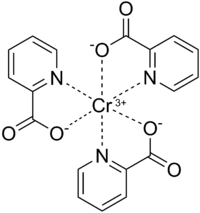
Photo from wikipedia
Background As mean HbA1c provides incomplete information regarding glycemic variability, there has been considerable interest in the emerging association between glycemic variability and macrovascular events and with microvascular complications and… Click to show full abstract
Background As mean HbA1c provides incomplete information regarding glycemic variability, there has been considerable interest in the emerging association between glycemic variability and macrovascular events and with microvascular complications and mortality in adults with and without diabetes. However, the association between long-term glycemic variability, represented by visit-to-visit HbA1c variability, and functional limitations has not been clarified in previous literature. The present study aimed to explore the longitudinal association between long-term glycemic variability, represented by visit-to-visit HbA1c variability and functional limitations. Methods This cohort study included adults aged over 50 years who participated in the 2006 to 2016 waves of the Health and Retirement Study. Physical functions, including mobility, large muscle function, activities of daily living (ADLs), and instrumental ADLs (IADLs), were assessed at baseline and every 2 years, and HbA1c levels were assessed at baseline and every 4 years. Visit-to-visit HbA1c variability was calculated using the HbA1c variability score (HVS) during the follow-up period. Generalized estimating equation models were used to evaluate the longitudinal association between HbA1c variability and functional limitations with adjustment for a series of confounders. Results A total of 5,544 participants having three HbA1c measurements from 2006 to 2016, having two or more physical function measures (including one at baseline), and age over 50 years were included in this analysis. The mean age at baseline was 66.13 ± 8.39 years. A total of 916 (16.5%) participants had an HVS = 100, and 35.1% had an HVS = 50. The highest HVS category (HVS =100) was associated with increased functional status score (β = 0.093, 95% CI: 0.021–0.165) in comparison with the lowest HVS category (HVS = 0). Sensitivity analyses using the CV and SD of HbA1c as measures of variability showed similar associations between HbA1c variability and functional limitation. An incremental increase in HbA1c-CV (β = 0.630, 95% CI: 0.127–1.132) or HbA1c-SD (β = 0.078, 95% CI: 0.006–0.150) was associated with an increase in functional limitation in the fully adjusted model. Conclusions HbA1c variability was associated with heightened difficulty in performing functional activities over time after adjusting for mean HbA1c levels and multiple demographics and comorbidities. This study provides further evidence regarding the detrimental effect of HbA1c variability and highlights the significance of steady glycemic control.
Journal Title: Frontiers in Endocrinology
Year Published: 2022
Link to full text (if available)
Share on Social Media: Sign Up to like & get
recommendations!